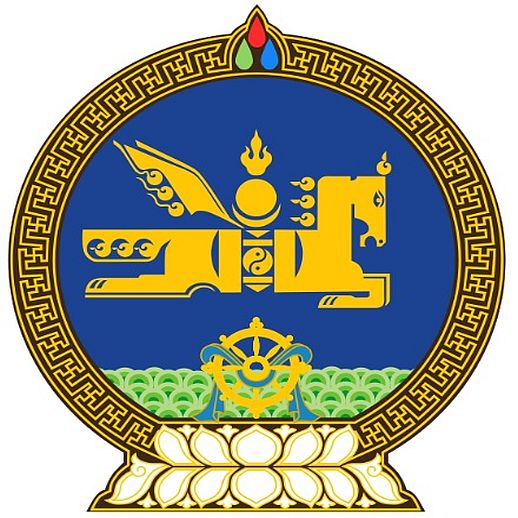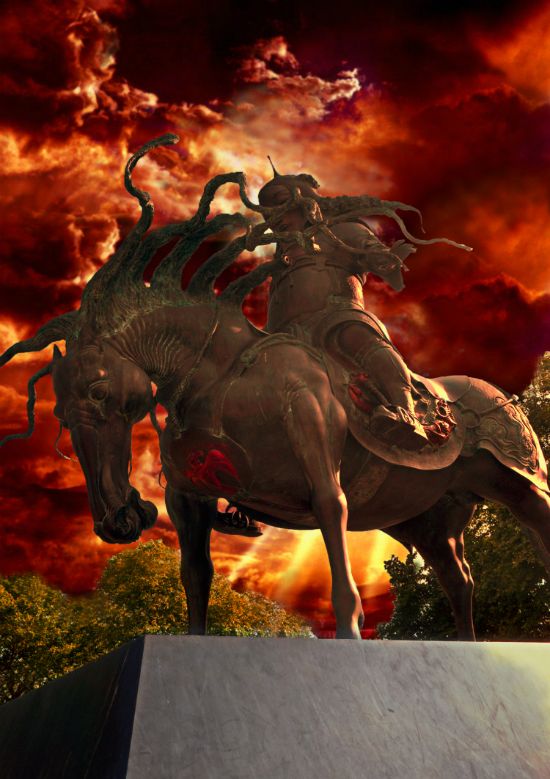Vedic Culture existed universally and there were multiple proofs found about this fact.
Mongolians too had a Blue God named Koke Mongke Tengri and a dharmic law called Yassa, developed by Genghis Khan.

‘It is ordered that all men should believe in God, the creator of Heaven and Earth, the sole giver of goods and poverty, of life and death as it pleases Him and whose power over all things is absolute.‘
So began the Yassa, the foremost law under the Mongol Empire. The Yassa was a written secret code of law developed by Genghis Khan. Born as Temujin, Genghis Khan was the founder of the Mongolian Empire. Prior to his rise the tribes of Mongolia loosely shared a common law. This law however was unwritten and variations existed amongst the numerous tribes. As Genghis Khan grew in power and influence, he developed this common law into an Imperial Code of Law called the Yassa. Compiled under the personal supervision of Genghis Khan himself the Yassa gave the world its first known written record of Mongolian ancestral traditions, customs and law. His step-brother Shikhikhutag, who was well-versed in Mongolian law, contributed greatly to the Yassa as well. His son Chagatai oversaw its implementation.
The world is familiar with the conquests of Genghis Khan yet few are aware of the deep mystical foundations of his legacy. Though many details in connection to Genghis Khan’s religion and his law code the Yassa have been lost to history, we can still glean an accurate understanding from the records of ancient writers. The Yassa or ‘Decree’ was a ‘Secret Law’ and a sacred one as well. It is believed to have been written in the Uigur Mongolian script and transcribed on scrolls, The Yassa was preserved in secret archives and only members of the royal family had access to them. The Yassa was known to a select few for, beyond being a code of laws, it was a work with profound metaphysical, spiritual, and mystical elements.
A small number of decrees of the Yassa were recorded by various ancient travelers and writers like François Pétis de la Croix., Fras Rubruquis, Giovanni da Pian del Carpine, Makrizi, Vartang, ibn Batuta and Juvaini. The Yassa was at one time enforced and long maintained by the Mongolian authorities throughout a vast part of the globe. At one point in history a majority of the world’s population lived and died according to the Mongolian legal code. Its imprint was enduring and extensive. Over the centuries scholars have thus been able to accurately record various aspects of the Yassa by combining the evidences available and comparing them with the ancient Mongolian texts and traditions.

“Although the Ilkhanate disappeared well before (the writer) al-Makrizi was born, the Yasa remained an important topic. In addition to being the enemy of the Ilkhanate, the Mamluk Sultanate had long been an ally and (at least from the Golden Horde’s perspective) vassal of the Golden Horde. Thus, an understanding of Mongol law was necessary. In addition, deserters from the Ilkhanate who could not flee to the Golden Horde took refuge in Mamluk territories, where they were received with honor. According to al-Makrizi, Ghengis Khan had the Yasa engraved onto steel tablet…” Great Yasa of Genghis Khan.
According to the ancient sources the Yassa began with a command to have faith in God. For devotion to God was at the foundation of Gengis Khan’s entire life. Various sources highlighted below provide an insight into the resolute commitment and spiritual foundation of the Mongol Empire.
Genghis Khan exhibited a rare tolerance and common sense rarely seen in lawgivers. This was exemplified in his ruling regarding liquor. “A man who is drunk is like one struck on the head; his wisdom and skill shall avail him not at all. Get drunk only three times a month. It would be better not to get drunk at all. But who can abstain altogether?”
As noted prior to the era of Genghis Khan, the Mongolians indeed shared a common law. The law, however remained unwritten, and many differences existed from tribe to tribe. Genghis Khan recognized the need for a common code and the Yassa was thus developed as a written record of ancestral traditions, customs and laws. Genghis Khan’s personal philosophy of life and his social and political ideals were also reflected within the Yassa and thus new laws were added constantly during his lifetime.
Anything that was written in the Yassa had to be followed exactly. This resulted in a robust discipline, which determined how the Mongols lived and interacted. This was noted by a Franciscan monk John of Plano Carpini who travelled to Mongolia In 1246. According to him the Mongols “showed more obedience to the law than any European clergymen”. For Genghis Khan was able to use obedience demanded from the Yassa to influence the morality of his people. He also influenced the mentality of his people with his personal charisma and the Mongol people voluntarily recognized his decisions as being divinely ordained. The success and triumphs under his command gave the Mongols a sense of self-worth, accomplishment and a direct recognition of the Grace of God upon their lives and their Nation.
Following his victories over the rival Mongol tribes, the Tribal leadership bestowed upon Temujin the title of “Genghis Khan,” “Chinggis Khan” or “Universal Ruler.” In Sanskrit this is Jagan Nath and ultimately it is a name of God. The title carried not only political importance, but it also had a deep mystical and spiritual significance. The leading Shaman declared Genghis Khan as the representative of the Supreme God of the Mongols Koke Mongke Tengri the ‘Blue Eternal God’. With this declaration of divine status, it was acknowledged that Genghis Khan thus had the ‘Mandate of Heaven’ to conquer and rule the entire world. The Mongols recognized that Temujin, now Genghis Khan, was in reality “…a Bogdo, (Sanskrit: Bhagavan-Dhan) a sending from the gods, endowed with the power of High Heaven.”
Genghis Khan was a divinely inspired man and rather than an overbearing megalomania his conquests were driven by Godly principles. He recognized the authenticity of the diversity of religious expression. His own mother was Christian and he also had several Christian wives. He recognized that regardless of any differences in practice the same God was being worshiped. It is also held that Genghis Khan was interested in Taoism and sought out the secrets of immortality. He however saw in this not a means towards personal empowerment for the sake of mere immortality but rather it was a potential path towards eternal service. Recognizing that he could never fulfill his divine mission within the short span of time allotted, Genghis Khan sought immortality.
Mongolian tradition of Blue Eternal God
The Great Mongolian Khans of the 13th century, beginning with Genghis Khan himself, ideologically based their power on a mandate from Tengri (God) himself, and began their declarations with the words ‘By the will of the Blue Eternal God.’
The Mongol spiritual tradition is marked by a descending hierarchy from the Sky to the Earth: the supreme divinity is Koke Mongke Tengri, the Blue Eternal God that is above all, the prime cause of the Universe. Under the Eternal Blue God exists a pantheon of 99 divinity or Tengri, often associated among them like the Tengri of the four cardinal points, the Tengri of the wind, the Tengri of the thunder or Erlig Khan the Tengri of the Dead. The Blue Eternal God permeates everything and every living being on the earth. Everything that lives on Mother Earth is under the protection of a divinity. In the Mongol devotional tradition both the Blue Supreme Being Tengri and the Protecting Spirits of places, are remembered in prayers and given offerings in supplication.
The Mongol tradition is one of humanties primal cultures and it is one of the oldest religions and cultural traditions of the world. The Circle, the Cross and the Swastika play the same sacred role within the ancient Mongol supernatural reality. The Sacred Disc symbol of God is at the center of yet another primordial religion. The universe of the Mongols can be visualized by a circle, not only in the three dimensions, but also in time itself. Everything has a circular motion, the path of the sun from day to day, the cycle of time from year to year, and the cycle of all living spirits as they return to earth to be reborn again and again, the circle of the axes (Swastika) with the four directions and the center of the world; the axes to the upper world, the Eternal Heavens and down to the lower world, the Mother Earth. Tengers (Devas), spirits, human souls, the fire and water are the elements of the vast arch of the sky. Paralleling the Vedic tradition of India the Sun and the Moon are the eyes of Blue Tengri. The Sun is fire energy and the Moon is water energy.
Mongol tradition holds that a form of Tengri resides at the crown of the head (the Crown Chakra); it is the point of connection between the individual standing at the center of his world and Heaven above. This point receives energy from Tengri which flows down the center of the person’s soul sphere. The form of Tengri in a person’s crown has a counterpart in a star in the Heavens. The star shines brighter or dimmer according to the strength of the person’s windhorse (personal power). At death, the star goes out. In Mongol tradition Father Heaven (Tengri Etseg) and Mother Earth (Gazar Eej – Etugan) constitute the central figures. Father Heaven is represented by the Timeless and Endless Blue Sky.
Even today that ancient globally prevalent symbol for God, the Winged Disc, finds a direct parallel in the current State Seal of the Mongolian Nation (top blue picture). Article 12 section 3 of the Mongolian Constitution explains the symbology behind the State Seal:
“The State Emblem shall be of circular shape with the white lotus serving as its base and the “Never-Ending Tumen Nasan” pattern forming its outer frame. The main background is of blue color signifying the Eternal Blue Sky (Koke Mongke Tengri) the Mongols traditional sanctity. In the center of the Emblem a combination of the Precious Steed and the Golden Soyombo sign is depicted as an expression of the independence, sovereignty and spirit of Mongolia. In the upper part of the Emblem, the Chandmani (Wish-granting Jewel) sign symbolizes the past, the present and the future. In the lower part of the Emblem, the sign of the Wheel entwined with the silk scarf Hadag in an expression of reverence and respect, symbolizes continued prosperity. It is placed against the background of a “hill” pattern conveying the notion of “Mother Earth.” Section XII of the Constitution of Mongolia.
The same deity is present within the ancient traditions of Mexico as well. Coqui Xee, the God of Infinity, ‘a supreme force or principle’ without ‘beginning or end’.
All deities were avatars, aspects, attributes, or reflections of Coqui Xee. He was known as Pije Xoo, or Pijetao in his form as time. He was the source of time. He is the god of the ‘thirteen movement’ who created the Parja (Praja, Progeny) begetters of gods and he ruled over ‘the thirteen gods of the zapotec sacred calendar.
The Aztec Calendar Stone with a Disc and Cross encircled by the Serpents of Eternity, represents the same theme.

